Those of you who have visited and walked around the Refuge HQ are familiar with Post Oak Creek.
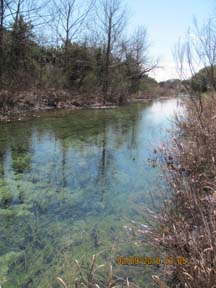
This is the stream that feeds the pond overlooked by the new photo blind. It runs down through the pecan grove, nurturing that lone Bald Cypress tree*, and thence under RM 1431, emptying into the Cow Creek arm of Lake Travis. Some number of you have had the opportunity either to join Jean & Seay Nance on one of their back-country hikes during the Songbird Festival or offered your services to help clean up the Bottom's Up Hunt Camp. You've seen a hint of what Post Oak Creek is like in the back-country.
I have taken the occasional opportunity--made up a thin excuse--to get away from the office and really go exploring in this watershed. Every time I wander the obscure trails and overgrown jeep roads which meander through the broken terrain, I find something interesting, experience something new, or see something that reminds me of the wonder of Mother Nature and the grand forces that shape the landscape.
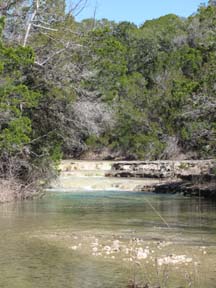
When I am not distracted by the birds or butterflies, every such hike offers up a geology lesson, a botany lesson, a hydrology lesson, or a history lesson, if I am just open to the possibilities.
Although I have enjoyed escaping to this habitat hideaway in the heat of a dry summer, it is in mid-winter--especially in a wet year like this--that the quietude of the landscape can be most appreciated, disturbed only by a noisy stream dashing over limestone ledges and riffles. No road noise. No overt sign of modern civilization. Nothing but ... nature. The existence of the old roads or the remnants of the hunt camp, and the near-ubiquitous evidence of past cedar cutting can be jarring in this context, but I take comfort that all that has come to a halt. An overgrown road, to me, means the land is slowly healing. A fallen tree is evidence of natural processes at work. Post Oak Creek and the processes of growth, death, decay, and erosion are gradually erasing most evidence of our species' previous influences here.
At various times and venues, I've shared images
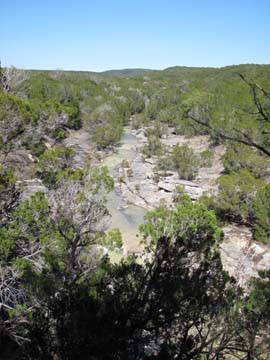
and told stories of some of my discoveries in this wonderland: energy flow through an ecosystem, a porcupine at close quarters in a crevice, a Varied Thrush glimpsed on one CBC and a Hutton's Vireo "documented" on another, a crystal-dappled ledge, the weeping hillside, and "The Rock", among other features. I reserve the right to withhold some of my memories of this place. Each of us should have a few of these, a reservoir of unshared moments in some special place, wherever that might be.
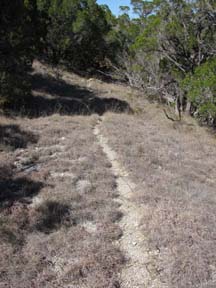
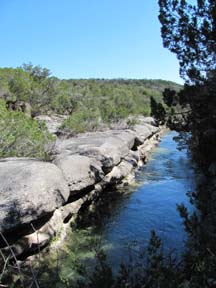 Left: The pathway to discovery.
Left: The pathway to discovery.
Center: Renewed and refreshed, Post Oak Creek carves through the limestone.
Above Right: A rugged watershed, viewed from high on a cliff.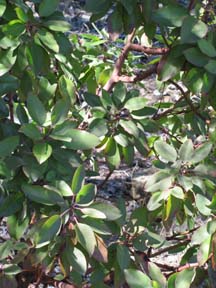
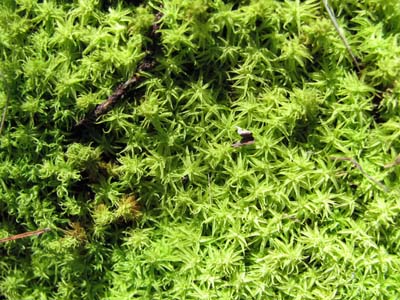 Left: A happy Madrone in a moist year.
Left: A happy Madrone in a moist year.
Right: Mossy pattern on a ledge. That said, I really wanted to bring to light what I encountered just today:
Four of the biggest, most massive, and most perfectly shaped Ashe Junipers I've ever seen! I had taken a slightly different path at midday today, easing along a scenic ledge and following an animal trail then an old cedar-chopper road down to a terrace flanking Post Oak Creek, nestled near the confluence of a major side canyon. It was a spot I hadn't previously visited. As I moved onto the level terrain, the woodlands grew in stature. There was an abundance of large Spanish Oaks, some healthy and others broken from various traumas of seasons past. Second-growth juniper--some of it middle-aged--made up the rest of the canopy and there was an annoying abundance of juniper slash scattered on the ground. But then I noticed one big straight tree trunk, two feet in diameter at the base, launching into the canopy. In the deep shade, I thought I perceived the bark of a juniper...but,
that big?! I couldn't even see the top of the tree as it emerged well above the surrounding woods. It
emerged!
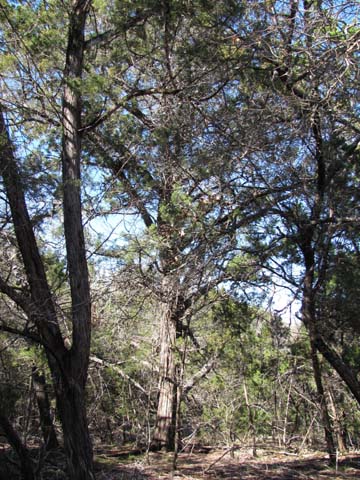 It's nigh impossible to photograph any single large tree in a forest.
It's nigh impossible to photograph any single large tree in a forest.
This was the most exposed of the four giants.
I glanced around to get oriented--to verify my location--and there, about 30 yards away, stood another massive juniper, and another, and another. (There may yet be more, but I was quickly engaged in documenting this find and didn't take the time to explore further.) I had nothing to measure them with so I set my field notebook at the base of one tree and reached up to hang my binoculars for perspective against the trunk of the giant, only to realize that the lowest available branch jutted out nearly 10 feet above my head. Each of these monsters is probably 50+ ft in height. Their age?--
Who knows!
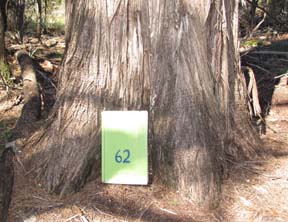
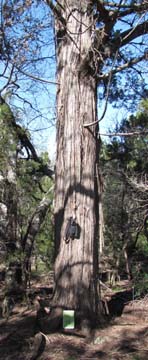 Trying to gain any perspective on the size of one of the giant junipers!
Trying to gain any perspective on the size of one of the giant junipers!
My field journal is 5" x 8". One or another of this set of trees may be the record Ashe Juniper on the Refuge. Time and more precise forestry measurements will tell. It was clear from their arrangement--and the thoroughly ravaged juniper woodland around the area, that these particular trees had been conscientiously spared from the saw. The cedar cutters probably made camp here on this terrace and retained a few big cedars to provide more shade alongside the oaks. Perhaps these trees were already so big that no useful posts or fence stays could be cut from the trees without a supreme expenditure of time, elbow grease, and fuel. Perhaps they were heeding "Chuck's Forestry Rule"*. In any event, for me, discovering a few trees like this is like stumbling upon a lost bison herd or remnant patch of tallgrass prairie. "
Just another day in paradise" ... as the country song says.
* See "Emergency Tree Protection" in my Dec. 8, 2009, entry.
* * * * *
Below The Line: I firmly believe that a great deal of landscape history can be learned from the varying shapes and growth patterns of junipers in a given location. Consider this: A single-trunked, straight-trunked juniper of necessity germinated and grew up in a dense woodland matrix. IF, hypothetically, these giant junipers--which may be 100-200 years old or more--grew up in such a woodland, that tells you something about what this little corner of the Texas landscape was like way back when these were just little seedlings! Other evidence comes, sadly, in the abundance of massive cut juniper stumps which one sees in many locations in the Post Oak Creek watershed. The happy news is that there are actually a few little protected niches, on the order of a few acres each, where we find intact old-growth woodlands showing no evidence of cutting or fire. Those are certainly special places.
